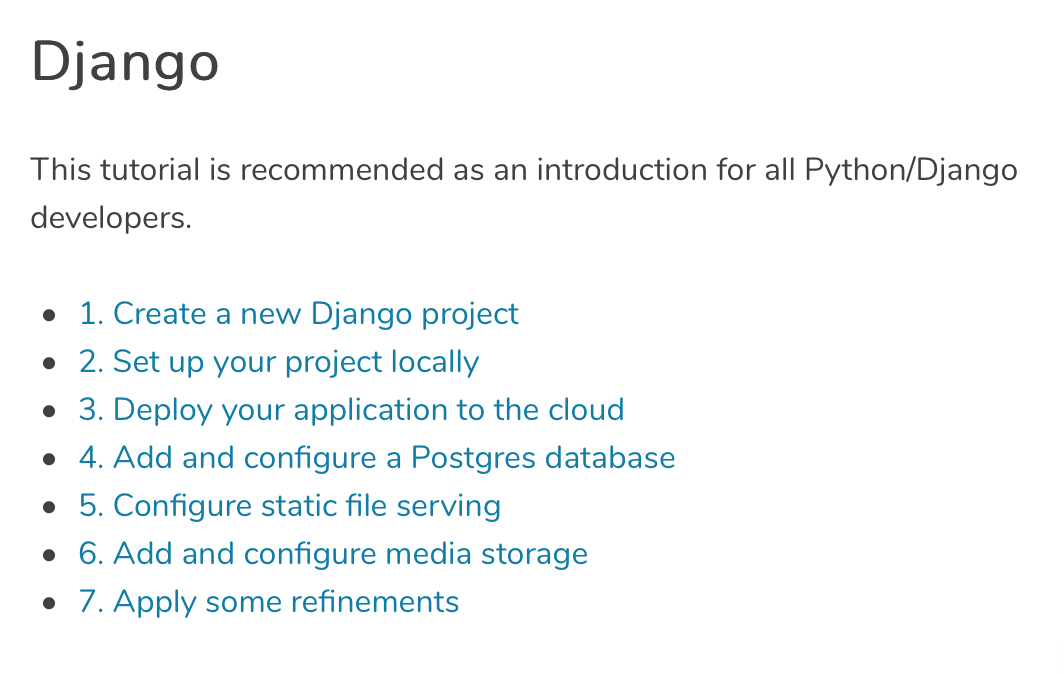Tutorials
Tutorials are lessons that take the reader by the hand through a series of steps to complete a project of some kind. They are what your project needs in order to show a beginner that they can achieve something with it.
They are wholly learning-oriented, and specifically, they are oriented towards learning how rather than learning what.
You are the teacher, and you are responsible for what the student will do. Under your instruction, the student will execute a series of actions to achieve some end.
The end and the actions are up to you, but deciding what they should be can be hard work. The end has to be meaningful, but also achievable for a complete beginner.
The important thing is that having done the tutorial, the learner is in a position to make sense of the rest of the documentation, and the software itself.
Most software projects have really bad - or non-existent - tutorials. Tutorials are what will turn your learners into users. A bad or missing tutorial will prevent your project from acquiring new users.
Of the sections describing the four kinds of documentation, this is by far the longest - that's because tutorials are the most misunderstood and most difficult to do well. The best way of teaching is to have a teacher present, interacting with the student. That's rarely possible, and our written tutorials will be at best a far-from-perfect substitute. That's all the more reason to pay special attention to them.
Tutorials need to be useful for the beginner, easy to follow, meaningful and extremely robust, and kept up-to-date. You might well find that writing and maintaining your tutorials can occupy as much time and energy as the other three parts put together.
Analogy from cooking

Consider an analogy of teaching a child to cook.
What you teach the child to cook isn’t really important. What’s important is that the child finds it enjoyable, and gains confidence, and wants to do it again.
Through the activities the child engages in, they will learn important aspects of cooking. They will gain experience with being in the kitchen, using the utensils, and handling the food.
This is because using software, like cooking, is a matter of craft. It’s knowledge - but it is practical knowledge, not theoretical knowledge.
When we learn a new craft or skill, we always begin learning it by doing.
How to write good tutorials
Allow the user to learn by doing
In the beginning, we only learn anything by doing - it’s how we learn to talk, or walk.
In your software tutorial, your learner needs to do things. The different things that they do while following your tutorial need to cover a wide range of tools and operations, building up from the simplest ones at the start to more complex ones.
Get the user started
It’s perfectly acceptable if your beginner’s first steps are hand-held baby steps. It’s also perfectly acceptable if what you get the beginner to do is not the way an experienced person would, or even if it’s not the ‘correct’ way - a tutorial for beginners is not the same thing as a manual for best practice.
The point of a tutorial is to get your learner started on their journey, not to get them to a final destination.
Make sure that your tutorial works
One of your jobs as a tutor is to inspire the beginner’s confidence: in the software, in the tutorial, in the tutor and, of course, in their own ability to achieve what’s being asked of them.
There are many things that contribute to this. A friendly tone helps, as does consistent use of language, and a logical progression through the material. But the single most important thing is that what you ask the beginner to do must work. The learner needs to see that the actions you ask them to take have the effect you say they will have.
If the learner's actions produce an error or unexpected results, your tutorial has failed - even if it’s not your fault. When your students are there with you, you can rescue them; if they’re reading your documentation on their own you can’t - so you have to prevent that from happening in advance. This is without doubt easier said than done.
Ensure the user sees results immediately
Everything the learner does should accomplish something comprehensible, however small. If your student has to do strange and incomprehensible things for two pages before they even see a result, that’s much too long. The effect of every action should be visible and evident as soon as possible, and the connection to the action should be clear.
The conclusion of each section of a tutorial, or the tutorial as a whole, must be a meaningful accomplishment.
Make your tutorial repeatable
Your tutorial must be reliably repeatable. This not easy to achieve: people will be coming to it with different operating systems, levels of experience and tools. What’s more, any software or resources they use are quite likely themselves to change in the meantime.
The tutorial has to work for all of them, every time.
Tutorials unfortunately need regular and detailed testing to make sure that they still work.
Focus on concrete steps, not abstract concepts
Tutorials need to be concrete, built around specific, particular actions and outcomes.
The temptation to introduce abstraction is huge; it is after all how most computing derives its power. But all learning proceeds from the particular and concrete to the general and abstract, and asking the learner to appreciate levels of abstraction before they have even had a chance to grasp the concrete is poor teaching.
Provide the minimum necessary explanation
Don’t explain anything the learner doesn’t need to know in order to complete the tutorial. Extended discussion is important - just not in a tutorial. In a tutorial, it is an obstruction and a distraction. Only the bare minimum is appropriate. Instead, link to explanations elsewhere in the documentation.
Focus only on the steps the user needs to take
Your tutorial needs to be focused on the task in hand. Maybe the command you’re introducing has many other options, or maybe there are different ways to access a certain API. It doesn’t matter: right now, your learner does not need to know about those in order to make progress.
Example from Divio's documentation
Have a look at our tutorials.

In particular, see the tutorial for Django. The promise that the tutorial makes is: if you have the basic knowledge required to follow this tutorial, and you follow its directions, you will end up with with a working Django web application, complete with Postgres database, S3 media storage, and so on. In order to work as a tutorial, it has to fulfil that promise.
Note that it doesn’t tell you what you will learn, just what you will do. The learning comes out of that doing. The tutorial takes full responsibility for what you will do and the order in which you will do it.